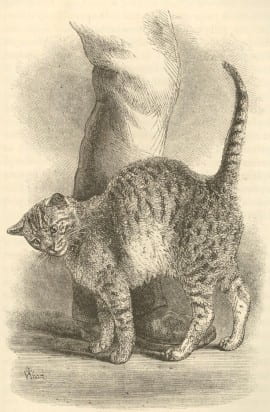Unrequited Love and the Instinctive Kind
Me, Dogs, Darwin and Biophilia
I am in love with Charles Darwin. This is a fact that guides my life. I included it in my profile for a dating site. This fact, I hoped, might deter many a romantic aspirant, drawing only those with an open mind, a sense of humor, justifiable self-confidence and ease about intellectual women. The dating site did not work out, my strategy notwithstanding. But I digress.
What draws me most to Darwin is his biophilia—Latin for the “love of life.” Modern definitions that describe Darwin’s include E.O. Wilson’s “urge to affiliate with other forms of life,” a sense of the one-ness of all life forms, the unity of nature, and an affinity with nature. Darwin wrote similarly about “one living spirit.” Nobel laureate Barbara McClintock had “a feeling for the organism.” As Darwin traveled through Latin America and around the world, thinking his proto-evolutionary thoughts and delineating the humans and animals he met, he manifested with pen and mind this love of life, as is clear in his notebooks and later books.

Birds and Butterfly by Frances Darwin | Reproduced by kind permission of the Syndics of Cambridge University Library (MS DAR 185; 109f22v).
Psychoanalyst Erich Fromm portrayed biophilia as the child of the urge for self-preservation—just as Darwin wrote “there is one instinct to all animals.” Fromm wrote of a biophile as a “person who fully loves life [and] is attracted by the process of life and growth,” who prefers “to construct rather than to retain, … [who] loves the adventure of living.” This describes Darwin perfectly and profoundly. I have written a whole book exploring Darwin’s biophilia and still have not done justice to the topic.
Darwin’s biophilia encompassed an encompassing love of dogs—his household nurtured some 21 dogs during his 43-year marriage—and, relatedly, an enchantment with interspecies interconnection. Darwin’s books offer charming vignettes of this sort: “I have seen one of the thick-billed finches picking at one end of a piece of cactus … whilst a lizard was eating at the other end; and afterwards the little bird with the utmost indifference hopped on the back of the reptile.” In The Descent of Man, he extolled the “capacious” heart of a captive baboon, who nurtured puppies, kittens and young monkeys, grooming all without discrimination, regardless of color, size, anatomical structure and vocal expression.

Cat in an Affectionate Frame of Mind by Mr. Wood, Darwin’s Expression of the Emotions in Man and Animals | Reproduced with permission from John van Wyhe ed. 2002-. The Complete Work of Charles Darwin Online. (http://darwin-online.org.uk/)
Today, an icon of interspecies connection is the much-lauded film, “E.T.” A human boy bonds with an extraterrestrial creature, and the human’s brother says his sibling “feels what he [E.T.] feels.” Interspecies talk and empathy—aka, biophilia’s sense of the oneness of living organisms— has been a trope for children at least since the emergence of the Cheshire Cat and Doctor Dolittle. “E.T.” extends interspecies connection beyond the confines of Earth, making biophilia interplanetary, literally universal.
Darwin was offered a chance to travel the world on a mapping expedition. He deployed several relatives to help tame his father’s objections. Darwin sailed and explored for five years, wandering across wildernesses from one natural wonder to another. Lord of the Rings author J.R.R. Tolkien told us, “Not all who wander are lost.” But Darwin was always lost in thought, even as his local guides benefited from his sharp marksmanship and appreciated his savvy with horses and dogs.
Many times in his travels, moments of interspecies connection provoked his mind and awe and charmed his biophile heart. In his 1839 Journal of Researches into the Geology and Natural History of the Various Countries Visited by the H.M.S. Beagle, he wrote, “I was amused by the dexterity with which a Gaucho forced a restive horse to swim a river,” a complex process involving stripping, gripping the horse’s tail and splashing at its face every time it tried to turn back, so it would seek the smoother waters ahead. Darwin described the two emerging on the far shore: “A naked man, on a naked horse, is a fine spectacle; I had no idea of how well the two animals suited each other.” “One living spirit” indeed. And note that two decades before publishing The Origin of Species, Darwin was already calling Homo sapiens an animal.
While in Uruguay, Darwin observed the training of shepherd dogs, detailing it in the Journal of Researches in a passage I love.
While riding, it is a common thing to meet a large flock of sheep guarded by one or two dogs, at the distance of some miles from any house or man. I often wondered at how so firm a friendship had been established. The method of education consists in separating the puppy, while very young, from the bitch, and in accustoming it to its future companions. An ewe is held three or four times a day for the little thing to suck, and a nest of wool is made for it in the sheep-pen; at no time is it allowed to associate with other dogs, or with the children of the family. The puppy is, moreover, generally castrated; so that, when grown up, it can scarcely have any feelings in common with the rest of its kind. From this education it has no wish to leave the flock, and just as another dog will defend its master, man, so will these the sheep. It is amusing to observe, when approaching a flock, how the dog immediately advances barking, and the sheep all close in his rear. . . . A pack of the hungry wild dogs will scarcely ever venture to attack a flock guarded by . . . these faithful shepherds. The whole account appears to me a curious instance of the pliability of the affections in the dog. . . . The shepherd dog ranks the sheep as its fellow-brethren, and . . . the wild dogs, though knowing that the individual sheep are not dogs, but are good to eat, yet partly consent to this view when seeing them in a flock with a shepherd-dog at their head.
Note his wildly anthropomorphic verbs: the “shepherd dog ranks the sheep as its fellow-brethren” and the wild dogs “partly consent to this view.” Sheep, shepherd, predator and observer share one point of view. Quite the unity of nature. Today Darwin’s biophile’s perspective is called “anecdotal cognitivism,” a method that is cousin to ethology, observing animals’ behaviors then inferring their thoughts and feelings.
Darwin’s perspective also justifies my life as ever shared with dogs as my boon companions. To me, it goes without saying or thinking, my deep, abiding and essential connection to dogs. My first pack-of-two dog was by my side in my twenties and thirties, as I moved four times. I was variously alone in the deserted winter of Cape Cod, in the throes of a job hunt, wobbling through a romance, employed, rejected, a young mother. Such changes were irrelevant to my dog, reducing them for me. Dogs excel in relishing the here and now. Their biophilia, to be sure.
They say people need hugs. I do not live with a person to hug. But my present dog, Mirkwood, leans on me with the hug’s “I’m here” press, time-stopping stillness and warmth. I live alongside a being who loves me. And I live with a being to nurture—crucial to health and contentment, they say. Moreover, this being wakes up happy every morning. A home containing happiness is a happy home, whether the happiness is human, canine or other.
I also cherish dogs’ interspecies connections. The way my second dog, Zeki, gently nosed our cat when she was ailing, a cat who never once in his life had failed to swat if he came near. There was the dawn when Zeki and I ambled in a park, Zeki carrying a log-sized stick, and a jogger pumping irons slowed down to ask, “What do they think they are doing when they do that?” My New York reply: “He’s feeling fulfilled.” The jogger grinned, displayed the weights, and said, “Well I guess I’m doing the same thing.”

Kay Harel with her dog, Mirkwood | Photo by Larry Sapadin
My home these days is on a dead end off a dead end next to a steep woods. My 105-pound Mirkwood has arrogated border patrol. He protects against bear and bobcat with ferocious barking and long chases, plying the lingua franca of territory. He is quite like the shepherd dogs Darwin admired in 19th-century Uruguay. Mirkwood has befriended the coyote. They howl as one. Sometimes, when the coyote start, he forays to their aid. He has tried for six years to play with the fox, but for all his aptitude in interspecies communication, the fox will never trust him.
Once, a man I was dating declared, “You have a weird relationship with your dog.” Reader, I married him. In hindsight, a mistake. Darwin did not make this mistake. Famously, Darwin’s thinking about dogs helped him to decide about getting married. As he compiled the pro and con, among the reasons to marry, he scribbled, “better than a dog anyhow.” Darwin, darling, I beg to differ: Only an ideal husband would be better than a dog. Or maybe not.
Kay Harel is author of Darwin’s Love of Life: A Singular Case of Biophilia. She has published essays on Edward Lear, William James and Wallace Stevens.
Related Articles
Editor’s Letter – Animals
Editor's LetterANIMALS! From the rainforests of Brazil to the crowded streets of Mexico City, animals are integral to life in Latin America and the Caribbean. During the height of the Covid-19 pandemic lockdowns, people throughout the region turned to pets for...
Where the Wild Things Aren’t Species Loss and Capitalisms in Latin America Since 1800
Five mass extinction events and several smaller crises have taken place throughout the 600 million years that complex life has existed on earth.
A Review of Memory Art in the Contemporary World: Confronting Violence in the Global South by Andreas Huyssen
I live in a country where the past is part of the present. Not only because films such as “Argentina 1985,” now nominated for an Oscar for best foreign film, recall the trial of the military juntas…



